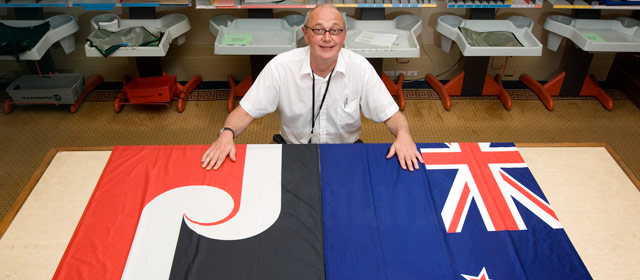Story summary
New Zealand has had three recognised flags.
United Tribes’ flag
In the 1830s British Resident James Busby believed a flag would solve shipping problems, unite Māori and encourage collective government. Chiefs met at Waitangi in 1834 and chose a flag, which became known as the flag of the United Tribes of New Zealand.
Union Jack
When the Treaty of Waitangi was signed in 1840 and New Zealand became a British colony, the Union Jack (the British flag) became New Zealand’s flag.
New Zealand flag
The current New Zealand flag is based on the British Blue Ensign, a naval flag. New Zealand ships flew versions of the Blue Ensign from 1865. A version with four red stars, symbolising the Southern Cross, became the official flag in 1902.
Māori flags
Māori designed their own flags, often depicting crosses, crescent moons and stars. Flags were used by the Pai Mārire prophetic movement, by resistance leader Te Kooti and by Māori kings and queens.
The tino rangatiratanga (Māori sovereignty) flag was designed in 1989, and became a symbol of Māori independence. At first the government refused to fly it on official occasions, but from 2009 it became the national Māori flag.
Other flags
Other flags used in New Zealand have included:
- Queen Elizabeth II’s personal New Zealand flag, which was flown when she visited
- the governor-general’s flag
- official flags used on ships and aircraft.
Changing the flag?
Calls to change the flag have been made since the 1960s. In March 2016 New Zealanders voted for the current flag in preference to the Silver Fern (Black, White and Blue) flag which they had chosen from among five options in an initial referendum in November 2015.
Law and protocol
Anyone can fly the flag at any time. It is flown every weekday on government buildings with flagpoles, and on special official occasions. The flag is flown at half-mast during times of mourning.
It is an offence to damage or destroy the flag with the intention of dishonouring it.
Protests
Flags are sometimes a target of protesters. In 1844–45 Hōne Heke cut down the flagpole above Kororāreka (Russell) four times. Other, more recent, Māori protesters have trampled on the flag or shot it. A protester against the war in Afghanistan burnt the flag in 2003. He was prosecuted but his conviction was later overturned.





